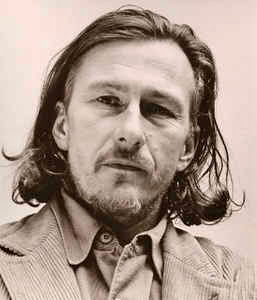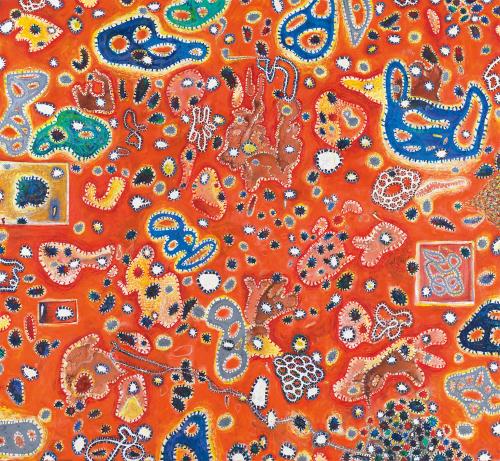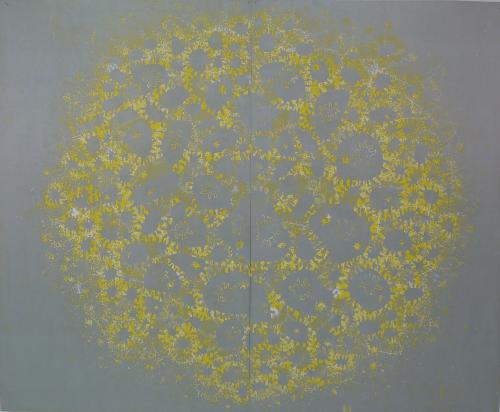
Gunter Damisch
Gunter Damisch was an Austrian artist known for his lush paintings of rhizome-like forms and undulating lines. “My pictorial system is strongly guided by the idea of transformation and metamorphosis. These ambiguities fascinate me,” he once explained. Born on May 20, 1958 in Steyr, Austria, he went on to study under Arnulf Rainer at the Academy of Fine Arts in Vienna, during which time he was a member of the punk band Molto Brutto. After finishing school, Damisch began exhibiting his work and established himself in the Viennese contingent of the Neue Wilde movement, alongside Otto Zitko and Hubert Scheibl. In the decades that followed, the artist was the subject of exhibitions both in Austria and abroad. Damisch died on April 30, 2016 in Vienna, Austria. Today, his works are held in the collections of a number of Austrian museums, including the Lentos Kunstmuseum Linz, the Museum Moderner Kunst Stiftung Ludwig in Vienna, and the Museum Liaunig in Neuhaus.
Gunter Damisch was primarily influenced by the 1970s. The art sphere of the 1970s was epitomized by a longing to evolve and reinforce itself, as a reaction to the many conflicts of the previous decade. One of the most central movement of the 1970s was Conceptualism, which appeared as an offshoot of Minimalism, while the experimental, creative journey of Process art emerged by combining essential elements of Conceptualism with further reflections on art itself. The initial ideas of environmentalism sprung from Land Art, which took art into earth itself, sculpting the land and bringing art to the outdoors. For the first time since the decline of Abstract Expressionism, Expressive figure painting slowly resurfaced and regained its prominence, particularly in Germany through the works of world renowned figures Gerhard Richter, Anselm Kiefer and Georg Baselitz. The city of New York remained as the most prominent artistic hub of the decade, with global artists drifting through the downtown scene, frequenting bars and art galleries, strengthening the idea of New York City as a cosmopolitan and sophisticated cultural capital.
Most of the dominant artistic figures of the 1960s remained greatly influential and popular throughout the 1970s. Andy Warhol, for instance, fortified his status as a legendary artist, by branching out into film and magazine publishing, thus instituting a ground-breaking concept of cross-cultural activity for a visual artist of such fame.
A few noteworthy global movements that sharpened the era include photorealism, which was initially introduced in the 1960s and reached commercial and critical success in the 1970s, as well as feminism which deeply influenced the visual culture. Artists such as Jannis Kounnelis, Mario Merz, and Michelangelo Pistoletto attained international success, as they were widely recognized as renowned members of the Italian movement Arte Povera, critically acclaimed in the 1970s.
In the eastern part of the globe, Japanese and Korean artists who showed a strong interest in the European ideologies of phenomenology, associated with the Mono-Ha movement, exploring and shifting the boundaries between natural and industrial materials. Using stone, glass, cotton, sponge, wood, oil and water, they aimed to create life to artworks that would accentuate the ephemeral state of these various elements and their surroundings, playing with their interdependency.
Reaching the end of the 1970s, street art, developing from graffiti, was starting to truly captivate the fine art community. Keith Haring and Jean-Michel Basquiat helped legitimize spray painting and tagging, demonstrating that their artworks could exist at the same time in art galleries and in urban settings. Following, the international extent of street art would become extremely influential, representing an extraordinary form of artistic expression.
EXHIBITIONS:
2014 Museum Moderner Kunst Wörlen, Passau, Germany
2014 Egon Schiele Art Centrum, Krumlov, Czech republic
2013 Galerie van de Loo Projekte, Munich, Germany
2012–2013 Teile vom Ganzen, Sammlung Würth und Leihgaben, Museum Würth, Künzelsau, Germany
2012–2013 Die Nacht im Zwielicht, Kunst aus der Romantik bis heute, im Unteren Belvedere und der Orangerie, Vienna, Austria
2012 Malerei 1982-2012, Thoman modern Innsbruck, Austria (solo)
2003 Galerie Eugen Lendl - New Space, Graz (solo)
Galerie am Stein, Schärding (solo)
Galerie Van de Loo, Munich (solo)
Galerie Lea Gredt, Luxembourg (group)
Traklhaus, Salzburg (group)
2002 ORF-Zentrum, Linz (solo)
Galerie Figl, Linz (solo)
Academia, Salzburg (solo)
St. Peter, Wiener Neustadt (solo)
Galerie Van de Loo, Munich (solo)
Galerie Van de Loo, Munich (group)
2001 Galerie 422, Gmunden (solo)
Galerie Elisabeth & Klaus Thoman (solo)
“Paper”, Galerie Fortlaan 17, Gent (group)
“Ein Garten für viele Träume - Teil 1 Pflanzen”, Galerie Ernst Hilger, Vienna (group)
Galerie Hilger, Siemens artlab, Vienna, Kunstverein Lingen, “ET IN ARCADIA EGO” (group)
Atterseehalle in Attersee, “Positionen - Malerei in Österreich” (group)
Livingstone Gallery, Den Haag, “Distant Beauty” (group)
Galerie im Traklhaus, Salzburg, “Anton Faistauer Preis 1987-2000” (group)
2000 Galerie Marie-José van de Loo, Munich, “von Alechinsky bis Zimmer - kleine Formate” (group)
-001132004-sculp.png)



